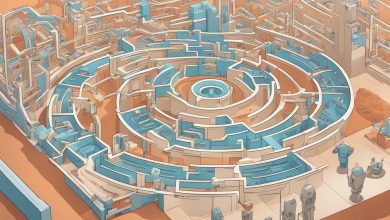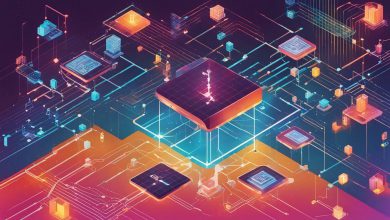
Welcome to the seamless world of IoT! With IoT solutions, we are now able to connect everyday devices in extraordinary ways. IoT connectivity has revolutionized the way we interact with our devices, creating a world where appliances communicate with each other and perform tasks without us even lifting a finger. From smart homes to healthcare, IoT has transformed our lives, making them more convenient, efficient, and enjoyable.
Thanks to the Internet of Things devices, we can now integrate appliances and devices into our daily routines, creating a truly connected ecosystem. IoT solutions have made it possible for us to control and manage devices remotely, eliminating the need for physical interaction and streamlining our activities. With the ability to analyze data and automate processes, IoT has opened up new possibilities, making the extraordinary an everyday occurrence.
Join us as we delve into the world of IoT connectivity and explore the benefits, challenges, and possibilities that it offers. Discover how IoT is transforming everyday devices, creating a seamless world where we can live, work, and play effectively and efficiently.
Get ready to experience the extraordinary ways in which IoT connectivity is changing the world!
IoT Integration in Everyday Life
The Internet of Things (IoT) has revolutionized the way we interact with everyday devices. Through IoT integration, devices are now connected and can communicate with each other seamlessly, resulting in a more convenient and efficient way of living.
Connected devices, otherwise known as smart devices, have emerged as a result of IoT integration. These devices can be controlled remotely, allowing for automation and ease of use. Smart home technology is a prime example of how IoT has transformed our everyday lives. A connected home can now be equipped with smart thermostats that regulate temperature based on usage patterns, smart lights that can be controlled via voice commands, and smart security systems that detect and alert homeowners of potential threats.
IoT applications have also made their way into various industries, improving processes and making them more efficient. In healthcare, connected devices are used for remote patient monitoring and data collection, allowing for more personalized and effective treatment. In transportation, IoT is used for asset tracking, route optimization, and predictive maintenance. In agriculture, IoT is used for soil and crop monitoring, leading to better yields and sustainable farming practices.
The Benefits of IoT Integration
The benefits of IoT integration are numerous. Connected devices allow for automation, which can save time and effort. With smart home technology, homeowners can control devices from anywhere, making it easier to maintain their homes. IoT integration can also lead to improved energy efficiency, reducing costs and supporting sustainability efforts.
IoT applications can improve efficiency and productivity in industries, leading to better outcomes and increased profitability. They can also lead to improved safety and security, as connected devices can detect potential threats and alert stakeholders in real-time.
Considerations for IoT Integration
While IoT integration provides numerous benefits, there are also considerations that need to be taken into account. One of the main concerns is data privacy and security. Connected devices can collect sensitive information, which must be protected to prevent unauthorized access. Interoperability is another consideration, as IoT ecosystems can be complex and may require different devices and systems to work together seamlessly.
Despite these considerations, the benefits of IoT integration far outweigh the challenges. As IoT technology continues to evolve, we can expect to see even more innovative and extraordinary ways in which everyday devices are connected and integrated into our lives.
The Future of IoT Connectivity
The seamless integration of IoT devices has transformed our lives in extraordinary ways, but what lies ahead for IoT connectivity? With the advent of edge computing and 5G connectivity, the future of IoT looks promising.
Edge computing allows for data processing and storage to occur closer to the source, reducing latency and increasing efficiency. This means that IoT devices can operate more rapidly and autonomously, enabling faster decision-making and improving overall performance. 5G connectivity will allow for even faster and more reliable transfer of data, making it possible for more devices to connect and communicate seamlessly.
These advancements in IoT technology will enable more sophisticated IoT applications to emerge in various industries, such as transportation, healthcare, and agriculture. From smart cities to self-driving cars, the potential for IoT is limitless.
Of course, as IoT solutions become more complex, challenges may arise. There may be concerns regarding data privacy and security, as well as issues with interoperability between different IoT ecosystems. However, with careful considerations and a focus on innovative solutions, the future of IoT connectivity remains bright.
Benefits and Considerations of IoT Solutions
The implementation of IoT solutions can bring many benefits to individuals and businesses, transforming the way we interact with and utilize everyday devices. By seamlessly connecting Internet of Things devices, IoT solutions enable automation, efficient data analysis, and predictive maintenance, leading to improved productivity and quality of life.
One of the main benefits of IoT solutions is the automation of routine tasks, such as turning off lights or adjusting the thermostat. With the help of smart home technology, this functionality has become more advanced, enabling users to remotely control their home devices through smartphones or voice commands.
In addition, IoT solutions allow for efficient data analysis, which can provide valuable insights for businesses. The data collected through IoT devices can be used to optimize operations, reduce costs, and improve customer satisfaction.
However, as with any technology, there are also considerations that need to be taken into account when implementing IoT solutions. One of the main concerns is data privacy and security. As IoT devices collect and transmit large amounts of data, there is a risk that this data can be accessed by unauthorized parties. Therefore, it is essential to implement strong security measures and ensure that data is encrypted and protected.
Another consideration is interoperability, as the various IoT devices and solutions currently available may not be compatible with each other. This can lead to challenges when trying to integrate different devices or systems, which could limit the potential benefits of IoT solutions.
In conclusion, IoT solutions offer an extraordinary range of benefits for individuals and businesses, from automation to improved data analysis. However, it is important to be aware of potential considerations, such as data privacy and interoperability, and take steps to address them in order to fully realize the potential of IoT applications.
The Seamless World of IoT: Connecting Everyday Devices in Extraordinary Ways
The Internet of Things (IoT) has transformed our lives by seamlessly connecting everyday devices in extraordinary ways. The innovative IoT connectivity has revolutionized the functionality of devices, leading to the emergence of smart home technology and various IoT applications.
IoT solutions have enhanced efficiency and convenience in various aspects of daily life. The future of IoT is even more exciting, with advanced technologies like edge computing and 5G connectivity promising further seamless integration of devices.
The Extraordinary Impact of IoT
IoT has been integrated into our everyday lives in different ways, having transformed ordinary devices into connected and smart devices. Smart home technology has revolutionized home security, energy management, entertainment, and more. IoT applications in industries such as healthcare, transportation, and agriculture have also showcased extraordinary ways in which IoT is impacting our lives.
Benefits and Considerations of IoT Solutions
Implementing IoT solutions can improve efficiency, productivity, and quality of life by enabling automation, data analysis, and predictive maintenance. However, potential concerns regarding data privacy, security, and interoperability in IoT ecosystems, must be considered.
The Future of IoT Connectivity
The future of IoT is promising, with new innovations and advancements in IoT connectivity. Edge computing and 5G connectivity will further enhance the seamless integration of devices. However, potential challenges and opportunities must be addressed for IoT solutions to achieve their full potential.
The Seamless World of IoT
The extraordinary impact of IoT in connecting everyday devices has revolutionized our lives, opening up limitless possibilities for the future. The seamless world of IoT is full of potential for innovation and advancement, promising to transform our lives in even more extraordinary ways.








